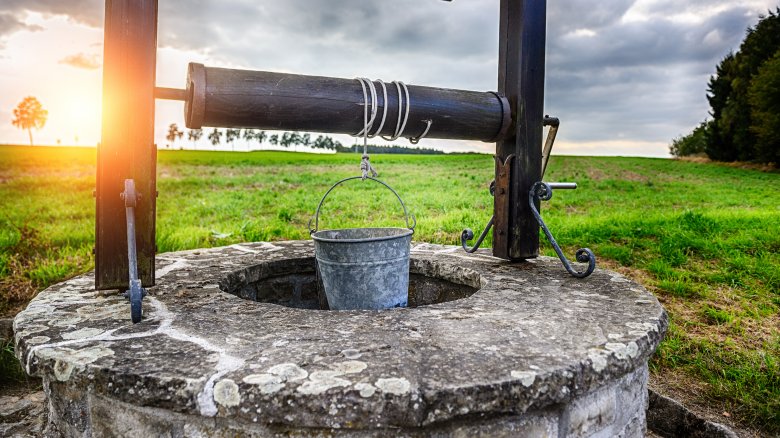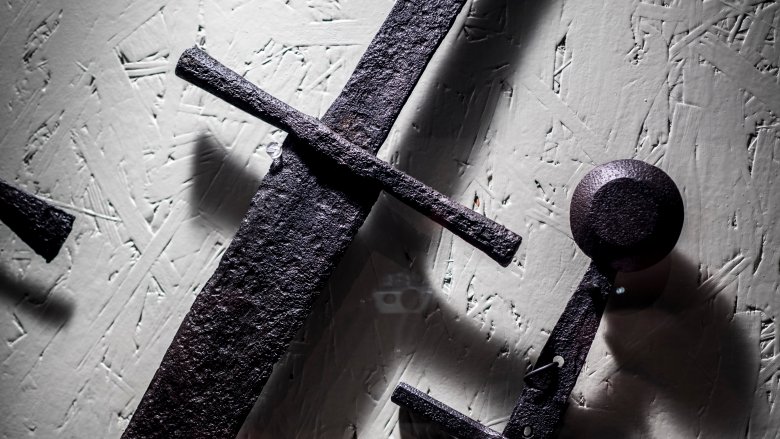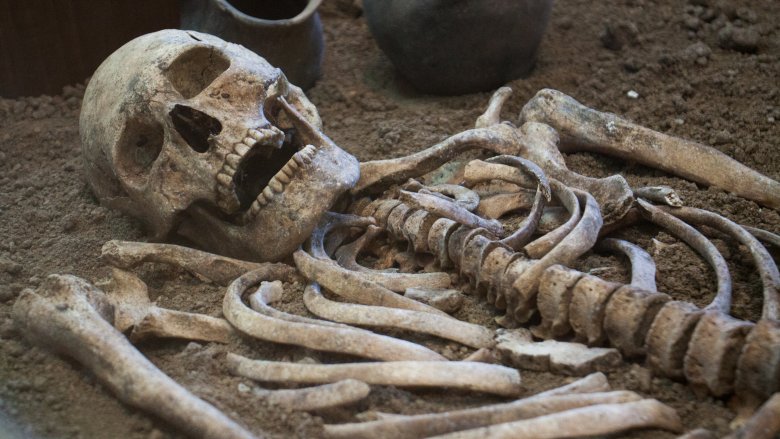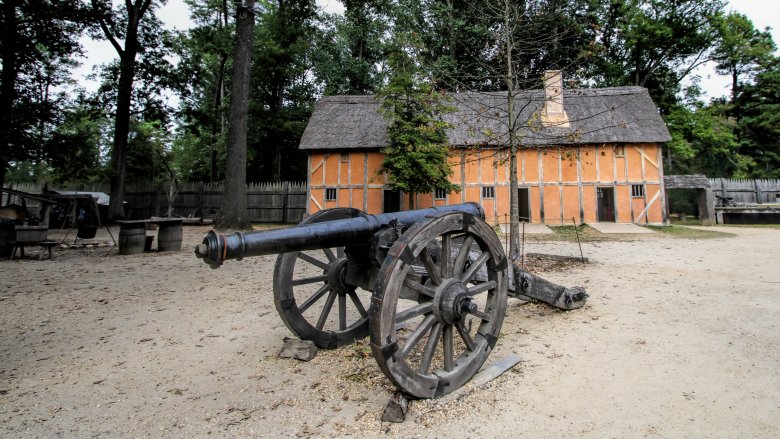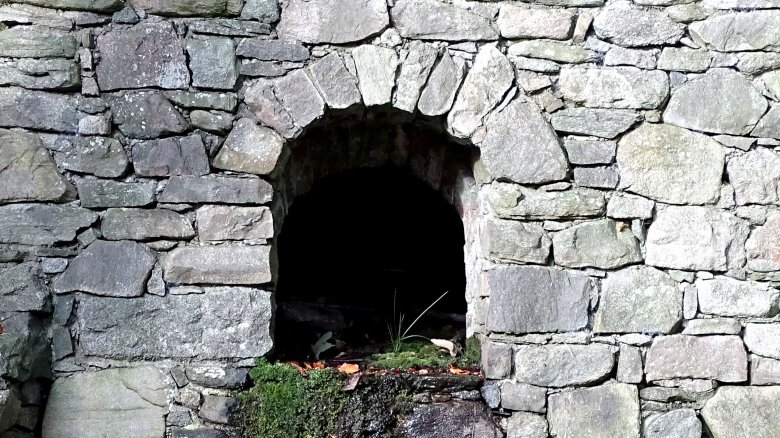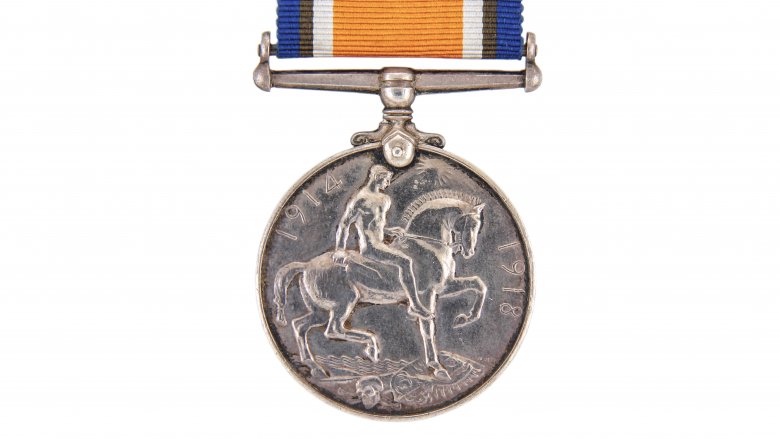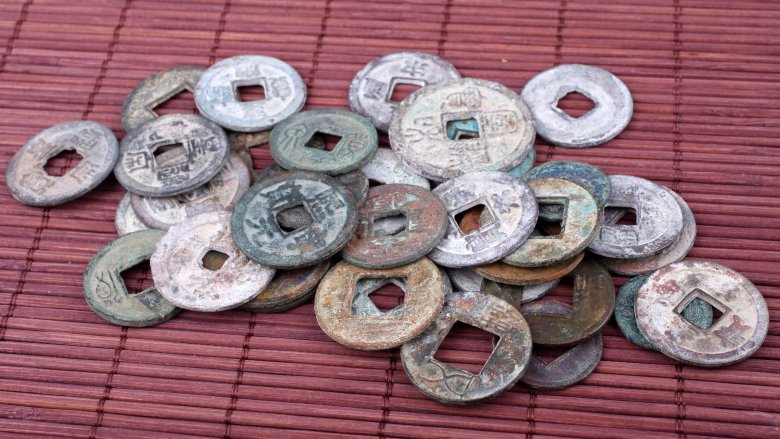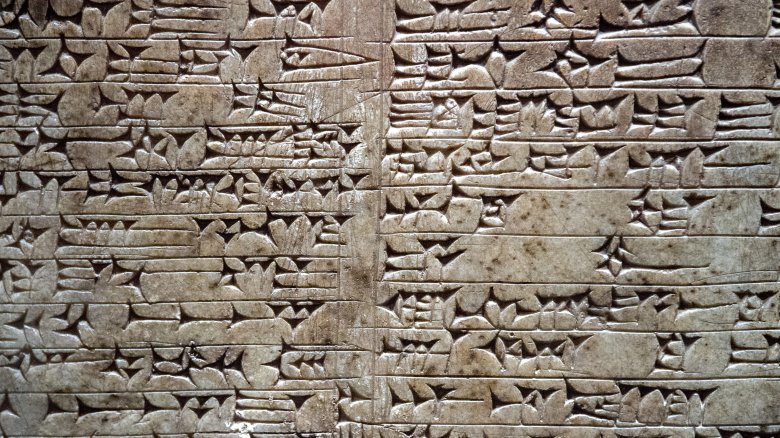Bizarre Things Found In Wells
Oh no, Timmy's in the well! Lots of other things are in the well, too, as it turns out. For a start, wells appear to be surprisingly common resting places for victims of suicide, murder, and "Oops I fell down a well," which, as Lassie was fond of reminding us, really just highlights the importance of not leaving uncovered wells lying around. But wells were also frequently used to discard trash (and one ancient person's trash is a museum's treasure) and to hide items of great value. A rather surprising number of museum labels contain the words "discovered at the bottom of a well," and the older the well, the more likely it is that you'll find something cool at the bottom of it. The trick is getting down there safely and bringing enough food so Lassie has time to go for help so you can eventually get back out again. No matter how cool the treasure is, we really don't recommend it.
Help, help, my fashionable Roman shoe is down a well
Human footwear can be found almost everywhere on planet Earth, usually lying discarded along highways and roads for bizarre reasons that will remain a complete mystery until the end of time. Sometimes they're just hanging on power lines, which is odd enough even before you really probe into the psyche of someone who thinks it's fun to toss shoes over power lines.
Most of the discarded human footwear we find on our nation's highways and power lines is relatively recent in origin, and probably still stinks of the last foot that was in it. But 2,000 years ago someone threw their old shoe in a well, perhaps because power lines didn't exist yet, and when it was rediscovered it looked pretty much exactly like it did when it was first thrown down there.
Today the shoe is in the Saalburg Museum in Bad Homburg vor der Hohe, Germany. The shoe is a full-foot design rather than a sandal, and is described by Open Culture as "fashionable," so probably not something that was worn by the average soldier. It's decorated with large and small perforations, rises above the ankle and is secured with laces. Really, it looks like something you might pick up at Zappos for $119.95, only way cooler and more broody because it survived 2,000 years at the bottom of a well.
Oops, dropped my sword
Sometimes we can sort of make sense out of why an object might end up in a well. Perhaps that Roman shoe was involved in an early game of keep-away, or maybe the wearer decided the style was so last century. And we all know Timmy was only down there because of TV ratings. But why were two European medieval swords in a well in India?
The two swords were discovered in Kottakkal in 2013 and have markings that suggest they are not of local origin — historians think the etchings are a medieval European style. But Europeans didn't hang out in India much during the Middle Ages. In 1502 the Portuguese established the first European trading center in Kerala, so the swords could have been from that time period. News site The Hindu also raises the possibility that they could be relics from the 18th-century Anglo-Mysore wars. They're an older design, but it's possible the French were still making swords of that type as recently as the 1700s.
How they ended up in a well is less clear. Maybe a couple retreating soldiers tried to disguise themselves as regular people. Or maybe they dropped the bucket down the well and tried to use their swords to fish it out. The only thing we know for sure is these kinds of mysteries won't ever be solved, and that's what makes them so much fun.
You might want to bathe in the river instead
Throwing people down wells is not just something done by modern psychopaths and the producers of heartwarming television shows about boys and their dogs. Ancient people loved to throw people down wells, too, so if you've ever felt like our society just doesn't have anything in common with Roman-occupied France, there you go.
According to Medieval Histories, in early 2014, archaeologists completed their excavation of a 9th-century (ish) Roman village called Intaranum. It was a tidy little village with rows of stone houses and hot and cold water bathing facilities. The baths got their water from wells, one of which was stuffed with the bodies of 20 to 30 different people — men, women and children. So if nothing else, that was really gross for the people who used that particular bathing facility.
The massacre itself isn't remembered, at least not specifically, but based on the time period historians speculate that the bones could have belonged to post-battle pillaging victims, or possibly victims of a band of Vikings, or maybe just victims of a random band of brigands. There's also the possibility that they died during a pestilence, though in that case throwing them down a well where the village gets its bath water is really very extra-gross.
Fracking is probably better for your well water
When fracking operations contaminate your well with methane, you can light your tap water on fire. That's pretty cool if you need a conversation starter when you're hosting parties, and if you never plan to drink, bathe, or cook anything in your house ever again. Now what if your well was contaminated by 300-year-old explosives? That's an even better conversation starter.
In early 2008, 100 missiles from the 18th century were found in an open well in Shivamogga, India. According to the Bangalore Mirror, the rockets are special not just because there are only five other known examples, but also because they are an advanced, iron-cased type, one of the first to be used to actually kill people rather than just as a signaling device.
During the Anglo-Mysore wars, which was perhaps a very popular time for throwing weapons into wells, the British were simultaneously terrorized by Mysore rockets and also thinking to themselves, "We really must get our hands on some of those Mysore rockets." When the British eventually won, they confiscated a bunch of the sultan's rockets, and then built some of their own based on the Mysore design. Those rockets were later used to defeat the armies of Napoleon.
How so many examples of those revolutionary weapons of war ended up mostly intact at the bottom of a well is a mystery, but it's probably safe to say that lighting them on fire as a conversation starter would be ill-advised.
Let's shoot this ancient artifact into space
When a package arrives at your door with a shipping tag on it, the shipping tag goes in the trash along with the box and all the packing material. (Shame on you, that stuff belongs in recycling.) You probably have never even considered keeping a shipping tag. It's okay because no one else in the history of shipping ever thought to keep shipping tags, which means old shipping tags are really rare.
So when archaeologists discovered a lead shipping tag at the bottom of a well during an excavation of historic James Fort on Jamestown Island, you wouldn't expect that that shipping tag would ever be flown into space. Because who would come to that conclusion after finding a 400-year-old shipping tag at the bottom of a well?
Well, NASA would. Weirdly, that's exactly what NASA decided ought to be done with the artifact. The logic behind the decision was that the shipping tag represented early exploration, traveled many miles between England and Jamestown, and then would represent the exploration of space along with two Jamestown commemorative coins, and oh we really have no idea. It doesn't actually make any sense at all.
Anyway, the tag got a ride on the Space Shuttle Atlantis, and then it came back and now lives in the Historic Jamestown collection of artifacts. So, whatever.
Shere Khan't get out of this well
Because India is evidently the place where they find most bizarre things in wells, in the fall of 2016 locals from the village of Khava were shocked to discover there was a tiger in their well. Yes, a tiger. As far as officials can tell, this particular tiger was not actually from the Anglo-Mysore war, so that's a bit of a surprise.
According to Ranthambhore Guides, the 3-year-old female, called Lighting, was living on the Ranthambhore Tiger Reserve when she had a mishap and not only fell into the well but also somehow managed to survive the 20-foot drop with only minor injuries. The well had a low water level, which was quite fortunate for the tiger, so she was never in danger of drowning. Cats, man.
The villagers who found her alerted the Forest Department, and a team of veterinarians was able to tranquilize her and lift her out of the well in a rescue operation that took only two hours. Lighting was returned to the reserve, and as far as we know lived happily ever after. Hopefully the villagers covered up the well, or at the very least trained a large collie to guard the area and run for help the next time another tiger has a similar mishap.
This water tastes like motor oil
By now it will certainly not surprise you to hear that this next bizarre thing was also found in a well in India.
According to IndiaToday, in 2016 residents of Bihar, India, gathered around an old well where the water had suddenly turned into oil, hoping to get rich. But because people pretty much suck in general, their hopes were dashed when a government official arrived on site to confirm the discovery. After said official verified that it was actually real, bona-fide oil and not just smelly mud, Indian Oil was notified, district administration took over, and now there are armed police officers guarding the well so no unauthorized person can come along and make themselves a little less poor.
Just in case you're thinking to yourself, "Wow, the law totally sucks in India," according to FindLaw if you discovered oil in your own backyard in the U.S., you might not be able to profit off it either because you have the property rights to your land but not necessarily the mineral rights. So if you discover oil in your well not only will you not really be able to bathe, drink, or cook in your own water anymore, but you may also find a couple armed police officers in your backyard. As it turns out, the law totally sucks pretty much everywhere.
An important piece of linguistic history, or a 400-year-old pencil sharpener
In a rare example of something bizarre that was discovered in well not located in India, in January 2010 a mysterious stone tablet was found in Jamestown, Virginia, home of the astro-shipping tag. This time archaeologists did not decide the artifact belonged in orbit, probably because it's quite large and heavy and also because most artifacts don't belong in orbit.
The tablet is covered with weird etchings that include both Elizabethan script and what appear to be drawings and symbols. According to National Geographic, researchers had to digitally enhance the images in an attempt to isolate individual details, and tentatively concluded that the symbols are from an Algonquian alphabet, which was developed to help European explorers learn to pronounce the local language. Or, it could just be where villagers sharpened their pencils because that's kind of what it looks like.
Jamestown's director of research and interpretation said the discovery was "like finding the Rosetta Stone." It not only includes the Algonquian symbols, but also drawings of plants, animals, and people, so it could potentially teach researchers a lot about life in historic Jamestown, unless NASA changes their mind and decides to put it aboard the next Falcon 9. You never know.
We dug through 85 feet of garbage and all we found was this stone arch
And then, because the universe just really wants this whole article to be about wells in India, workers who were cleaning out a historic well in Bidar, India, discovered a 10-foot-tall arched doorway at the bottom. The structure is pretty elaborate, with a large cornerstone, two supporting beams, and two sets of stairs on either side. The assistant director of tourism at the site told The Hindu that the structure was probably part of an underground drinking water system built in the 1300s.
The well where the arch was found was a "step well" built during the Middle Ages. It dried up in the latter part of the 20th century, and then residents decided they might as well use it as a garbage dump because hey, what else are you going to do with a dried-up historic well? Workers assigned to clean out the old well had to remove 85 feet of trash before making the discovery at the bottom, which really does sound like the most unpleasant job ever, but at least they found something cool beneath all that smelly trash. It probably doesn't totally make up for having 30 years' worth of garbage stuck under your fingernails, but it's something, anyway.
Facebook is good for so much more than just invading your privacy
In 1984, a British police officer named Pete Carson found a World War I medal while helping clean out a garbage-filled well at Inverness Castle because evidently you are actually supposed to throw trash into dried-up medieval wells. A worker discovered the medal under about 25 feet of disgusting garbage, and Carson decided to make it his life mission to find out who it had once belonged to.
According to the Scotsman, he was able to find the name of the owner along with some service history and dates. The medal was originally issued to Private William Smellie Hogg. Let's pause for a moment. It's really difficult to get past that guy's name without making fun of it, but we're going to try. We'll just say we hope it was a nickname and not something his parents saddled him with. Moving on.
Carson's search was derailed when he learned that Hogg's World War I records were destroyed in a World War II bombing raid. But he was undeterred. Finally, he got in touch with someone who knew of the Hoggs and evidently also the Smellies. (Yep, it's a family name.) He found some genealogical records and finally located Hogg's grandson on, you guessed it, Facebook. And so the story of the lost medal found in a well that was not in India has a happy ending, with the medal returned to its rightful Smellie Hogg. (Sorry.)
In China finders are not keepers
Of all the awesome things one might find at the bottom of a well, money is about the best. Well, it depends on your priorities, but nobody dislikes finding money, whether it's under a rock or at the bottom of a well. If it's ancient money, that's pretty cool, too, but it gets complicated.
According to China's government-run media outlet, in 2011, workers on a construction site in China's city of Suzhou discovered some ancient coins in the bottom of a well. By the time archaeologists were done digging they'd found more than 200,000 of them. The horde, which weighs close to 9,000 pounds, probably dates back a thousand years to the Song dynasty.
Authorities believe the coins originally belonged to a wealthy family, who probably stashed their fortune in the well before fleeing a war and then never returned for it either because they were killed in the violence or because it just wasn't ever safe to return. So the large fortune remained down there for centuries, finally to be unearthed by some lucky construction workers. Except that luck really doesn't have anything to do with it, because unlike the United States, which has laws that typically allow finders to keep buried treasure, in China all buried treasure automatically belongs to the government. So maybe finding ancient money inside a Chinese well isn't quite as awesome as it sounds like it should be.
What if someone finds out he was awesomer than me?
Digging modern garbage out of a well is just gross, even if you find a World War I medal or a cool stone arch at the bottom. In the end, you really can't say much except that you just completed a king-sized dumpster dive that was marginally more profitable than the dumpster behind Target and at least a million times grosser.
Ancient garbage is at least less offensive. Anything smelly, rotting, or horribly textured turns to dust as the centuries pass, so you're left with only the cool stuff. According to Research Italy, archaeologists found a well full of ancient trash in Karkemish, a dig site on the border between Syria and Turkey. The well contained items like tokens and utensils, but the most important find was clay table fragments bearing the words of deposed King Sargon II, which were apparently cast into the well after the new king, Nebuchadnezzar II, had a little fit about whether someone, someday, might be able to read the words of his predecessor.
What exactly was in those tablets that new king disliked so much? Apparently, Sargon was mostly just going on about how awesome he was and how everyone loved him. So it's not really that surprising that Nebuchadnezzar was so annoyed. Man-babies don't really like to hear how cool other man-babies are, and own the well they went, to be discovered by dumpster-diving archaeologists more than a millennia later.
